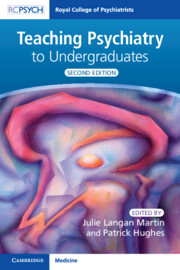Book contents
- Teaching Psychiatry to Undergraduates
- Teaching Psychiatry to Undergraduates
- Copyright page
- Contents
- Contributors
- Section 1 Principles of Medical Education
- Section 2 The Undergraduate Psychiatry Curriculum: Planning and Delivery
- Section 3 Clinical Placements in Psychiatry
- Section 4 Formal Teaching
- Chapter 4.1 How to Give a Lecture
- Chapter 4.2 How to Do Small Group Teaching
- Chapter 4.3 Case-Based Learning
- Chapter 4.4 Role Play and Experiential Learning
- Chapter 4.5 Simulation
- Chapter 4.6 Balint Groups for Medical Students
- Chapter 4.7 Teaching the Mental State Examination: An Example of Multimodal Teaching
- Section 5 Materials Development
- Section 6 Gathering feedback and quality improvement
- Section 7 Student Welfare
- Section 8 Developing as a medical educator
- Index
- References
Chapter 4.5 - Simulation
from Section 4 - Formal Teaching
Published online by Cambridge University Press: 12 October 2022
- Teaching Psychiatry to Undergraduates
- Teaching Psychiatry to Undergraduates
- Copyright page
- Contents
- Contributors
- Section 1 Principles of Medical Education
- Section 2 The Undergraduate Psychiatry Curriculum: Planning and Delivery
- Section 3 Clinical Placements in Psychiatry
- Section 4 Formal Teaching
- Chapter 4.1 How to Give a Lecture
- Chapter 4.2 How to Do Small Group Teaching
- Chapter 4.3 Case-Based Learning
- Chapter 4.4 Role Play and Experiential Learning
- Chapter 4.5 Simulation
- Chapter 4.6 Balint Groups for Medical Students
- Chapter 4.7 Teaching the Mental State Examination: An Example of Multimodal Teaching
- Section 5 Materials Development
- Section 6 Gathering feedback and quality improvement
- Section 7 Student Welfare
- Section 8 Developing as a medical educator
- Index
- References
Summary
This chapters explores simulation in psychiatry highlighting its two main purposes: teaching advanced communication skills, and exposure to specific clinical situations. The advantages to using simulation are explored and the key ingredients required for simulation to be done well are considered.
- Type
- Chapter
- Information
- Teaching Psychiatry to Undergraduates , pp. 102 - 109Publisher: Cambridge University PressPrint publication year: 2022

